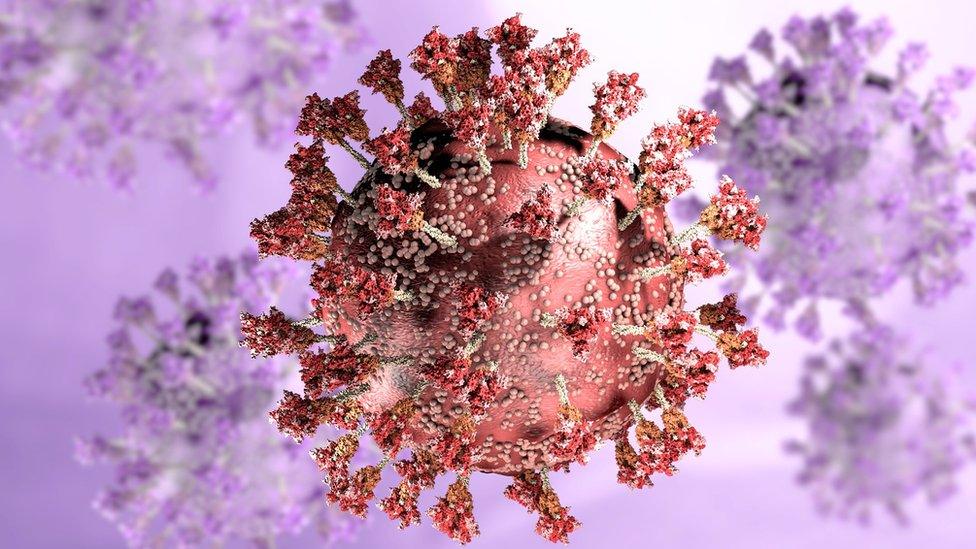The latest lab science on Omicron's threat
- Published

Here are two big questions: how fast can Omicron spread? And how sick will it make you?
Understand those and you understand the threat and the challenge posed by Omicron.
Scientists around the world are now making the first stabs at answering those questions and giving us hints of what's in store.
Immunity is critical, Omicron has not rewound the clock to the start of the pandemic, but uncertainty clouds everything and definitive answers could be weeks away.
How quickly is it spreading?
The answer seems to be fast.
And that applies even in places where there are high levels of immunity, either through vaccination or big waves of Covid in the past.
South Africa had seen the end of its Delta wave and was averaging less than 300 cases a day a month ago. Now it's more than 10,000, external with Omicron seemingly the driving force behind their fourth wave.
The UK has seen Omicron spreading too.
Scientists have been able to track their Omicron quarry by the unusual set of footprints it leaves behind in Covid tests. It's known as S-gene dropout and in late-November only 0.1% of test results had this footprint. It's now in excess of 5% which would suggest about 2,500 new cases a day.
This is not an infallible way of measuring the speed of Omicron's spread as imported cases and targeting testing to find the variant distorts the figures.
But it has allowed a rapid estimate to be formed without having to wait for a full genetic analysis of viral samples.
Those early calculations - and there is still uncertainty - suggest cases of Omicron may be doubling roughly every three days in the UK.
That is faster than Delta in the UK and is comparable to the speed of the original virus when we had no immunity back in early 2020.
This could be partly down to a shorter gap between you catching the virus and passing it on to somebody else.
The power of exponential growth - think snowballing credit card debt - is that a small number can rapidly become a big one. About 2,500 daily cases would exceed 100,000 a day by the end of the month, if cases did double every three days.
Will I catch it and will I get ill?
So if a wave of Omicron could be coming, what does that mean for me?
The worry since scientists first saw the list of mutations on Omicron is it would make vaccines less effective. It just looks so different to the original virus that was used to design the vaccines.
We now have the first data on how our immunity might hold up from experiments using neutralising antibodies. These stick to the surface of the coronavirus to stop it infecting cells.
Studies have suggested a 20 to 40-fold reduction, external in the ability of these antibodies from double-vaccinated people to take out the virus.
It is too big a leap to say what laboratory studies mean in the real world, but fewer protective antibodies suggests a higher risk of catching Omicron even for those who are vaccinated.
But then came the good news. Experiments by Pfizer-BioNTech have shown a third dose massively boosts levels of neutralising antibodies. Results suggest that three doses fare as well against Omicron as two doses did against the original variant, which was very good.
Prof Eleanor Riley, from the University of Edinburgh, described the data as "reassuring" as "this suggests that a booster should provide high levels of protection against infection and severe disease".
We still don't have clear answers about how severe an Omicron infection is and we won't know for sure until people start turning up in hospital.
But even if you have only had two doses of a vaccine, or even a past infection, then your immune system is still likely to be in better shape to fight Covid than at the start of the pandemic.
Neutralising antibodies are only one component of a your hugely complicated immune system.
T-cells are another part of your body's defences and they learn to recognise when cells in your body have been infected with coronavirus and promptly destroy them.
T-cells are much better at dealing with new variants. Early analysis suggests 80% of the parts of the virus that vaccines have trained T-cells to attack are unchanged in Omicron.
So what could happen?
There is the potential both for a wave of Omicron and for vaccines to do a good job at preventing most people becoming seriously ill.
The issue even if most of us are completely fine, is that that is not everyone. Some of us are frail, some don't have immune systems that respond well to the vaccine, some can't be vaccinated and some have chosen not to be vaccinated.
We are seeing that now with the Delta variant and the number of people still needing hospital care for Covid.
A sudden sharp wave could lead to all of those people needing treatment around the same time.
"It shunts everything together," said Prof Michael Tildesley, from the University of Warwick.
He added: "So there is the possibility of a big wave similar to what we had in January and at some point that will lead to an increase in hospitalisations."
But he warns there is still huge uncertainty in all the data.
There aren't universally agreed numbers for how fast Omicron spreads, how severe it is or how much it evades vaccines. So you get a radically different view of the coming weeks depending on which numbers get plugged into the mathematical models.
"You can get everything from no wave, to a wave there's no need to worry about, to doomsday; that's the problem there is massive uncertainty," he said.
Follow James on Twitter, external
